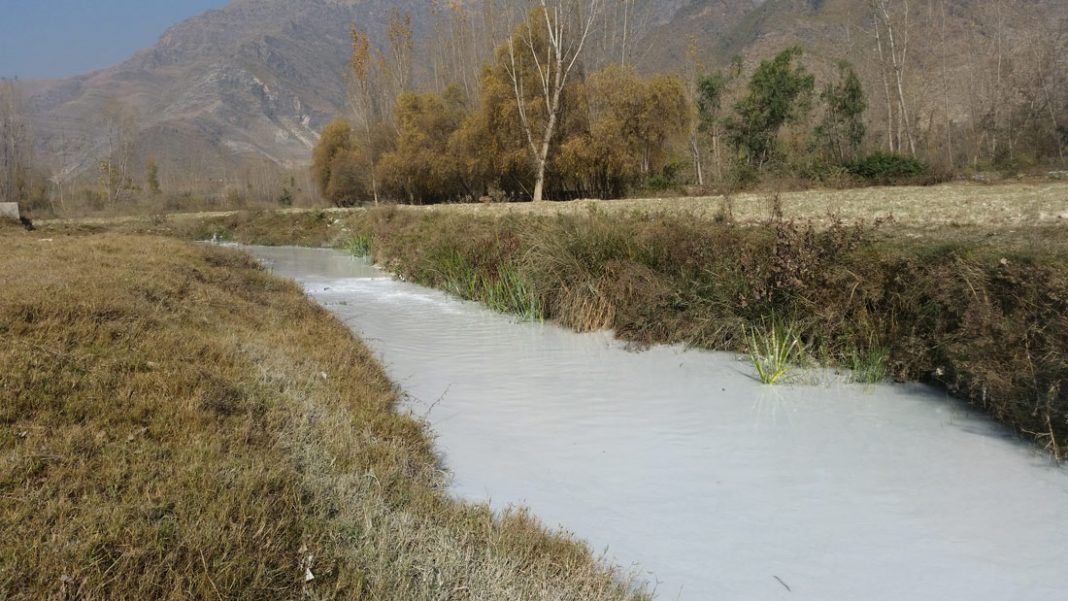Buner: Israr Hussain, a resident of Pir Baba, Buner, says that white powder runs through Buner’s water like a virus runs through human blood. He points to the river that has turned to a thin milky slush from the sediment

from marble industries in the district.
“The streams and rivers running across Buner were as clear as crystal before marble-extraction became a local industry,” says Hussain. “With their arrival, industrial waste in the form of dust and white powder has increasingly choked nature and made people sick.”
The factories are situated close to rivers in the district as they need water to wash the marble tiles. The waste for these units is seen running directly into streams and rivers. According to Murad Ali Khan, Vice President of the Marble Industrialists Association in Buner, the marble industry in Buner started in 1992 but they the rise in the number of units happened after the year 2000.
According to the Federal Boards of Revenue’s Directorate of Training and Research, there are 160.2 million tons of marble reserves in Pakistan. Of these reserves, 158 million tons are based in the Khyber Pakhtunkhwa province. Of all the districts in the province, Buner alone possesses 50 percent of the total marble reserves of KP. Local industrial units extract and process marble for a national market and depending on their capacity, says the directorate’s report, nearly 300 tons of marble are extracted each day in Buner.
A study published by the International Journal of Recent Scientific Research says “the spills of waste/calcium from marble industries [in Buner] in some areas [have been] harming human lives and spreading diseases in the form of kidney problem/ kidney stones, skin and eyes diseases.”
“These industries not only affect human lives but also threaten aquatic biodiversity, natural beauty and crop production in the area,” says the study titled “Pollution Load in Industrial Effluent and Groundwater due to Marble Industries in District Buner.” The study states that there are as many as 400 marble factories in Buner and all of them contribute to local river water pollution.
Dr. Umar Farooq, a nursing officer at the District Headquarters Hospital Daggar in Buner, says patients from the marble factory regularly visited the facility. He said roughly 50 per cent of these patients complained of respiratory diseases caused by marble dust. In some cases, he said, patients had cancer of the lungs. “The blast in the marble mines produces dust that could result in serious respiratory problems,” adds Farooq.
According to Dr. Tariq Ahmad, Assistant professor at Bacha Khan Medical University, the marble waste running through the streams and rivers contains calcium carbonate that is ultimately absorbed by the land. “People using ground water within a kilometer of such streams are susceptible to developing kidney stones,” said Ahmad. “Due to this, the problem of kidney stones is more pronounced in the areas around marble factories. It needs a research to know exactly if the ground water is causing kidney stones.”
Another study observes the adverse effect of marble spill on dragonflies, “Biodiversity of Dragonflies and their Life Threatening Factors in Buner” shares this observation: “Dragonflies, a very important component of ecosystem and effective biocontrol agent of crop pests are at threat in district Buner, due to the continuous spills of marble and pesticide factories in fresh water bodies.”
Says Salman Ahmad, a resident of Buner city, “The rivers that were once popular spots for fishing and swimmers are now a threat to them due to industrial waste. The money from the marble units goes into a few pockets while their pollution has disturbed the whole area. The government must take proper steps to preserve the environment from further degradation”.
Director general Environmental Protection Agency (EPA), Dr. Muhammad Bashir Khan, told News Lens that the white powder residue produced by marble industries is not toxic in itself. However, as a sediment and pollutant, it becomes a real threat to environment when discharged into water bodies in such large quantity as in Buner.
“The continuous spill of marble waste affect the agricultural lands by depositing a layer of sediment waste, 7 to 8 inches thick, on their surface,” says Khan. “It also affects aquatic life as marine life cannot breathe in polluted waters,” he adds.
Khan said EPA had provided a model to the marble units for a settling tank to filtrate industrial waste. Some of the marble factories in Buner did adopt the EPA designed model to filtrate industrial waste. However, he said, there was no proper place where the waste from the settling tanks should be dumped.
The previous government of Awami National Party (ANP) had proposed the Buner Marble City project under which all industrial units would be based in one place, making it easy to process the industrial waste and provide raw material to marble factories. The project was taken up by the present government of Pakistan Tehreek-e-Insaaf and according to the budget document, the KP government allocated a sum of PKR 300 million in the 2013-14 budget for the establishment of Buner Marble City. However, the project has been long in gestation.
“The Buner Marble City project is a good idea to overcome pollution in the area,” says Khan. “However, it is a long term project and industrialists may not be willing to shift their units to the Marble City. It is good for those planning to start marble industries in future”.
In February, 2015, the Peshawar High Court’s Green Bench ordered closure of 45 marble units in Buner for violating Environmental Protection Orders (EPOs). An EPA document obtained by News Lens Pakistan, says the agency issued notices to 180 units – out of the 256 inspected by EPA in Buner – for violation of EPOs in 2014.
Presently, the issue of marble pollution is under court review. In August 2016, the Peshawar High Court summoned high officials from the local government department in Khyber Pakhtunkwa to arrange for acquisition of land to dump industrial waste of marble factories in Buner.
According to Sajid Nawaz, an official at the KP Economic Zone Development and Management Company (KPEZDMC), the case is with them for review since October 2016. The company is regularly attending the proceeding of the courts to update it on progress on acquisition of land. Nawaz said that they are currently evaluating the cost of local land availability for setting up the Marble City.
Murad Ali khan, Vice President of the Marble Industrialists Association in Buner, said the Marble City had not materialized because the site suggested for the project fell on agricultural land. He said the newly established KPEZDMC was now working on the project. “However, the project implementation process is still very slow.”
Khan said all marble units in Buner had built settling tanks for filtration of industrial waste. Depending on production capacity, a settling tank could fill up with waste in a week, he said. “To take that waste out of the settling tanks and to dispose it is a real problem. There are no dumping sites for industrial waste in the area. Dumping the waste in streets may result in further pollution.”
He said the local marble industry had asked authorities to provide dumping sites in five areas of Buner at Pirbaba, Towarask, Deewana Baba, Cheena and Salarzai. However, said Khan, a decision on this was still awaited. To him, “even allocation of dumping sites was not a solution to pollution and the Marble City must be established keeping in mind a lasting solution to the problem.”
Khan said the marble units in district Buner produced 10 different types of marbles and engaged 80,000 to 100,000 workers. The locally produced marble tiles are taken to markets in Karachi and Lahore, and thereafter exported to other countries.
Nawaz of KPEZDMC says: “There are models available to help reprocess industrial waste of marble industry for use as raw material cement industry, ceramics, pharmacy, detergent and other products.”
For reprocessing marble waste, he said, the company was going to engage the Chemical and Mechanical Department of the University of Engineering and Technology Peshawar to analyze the waste samples. “On analysis, we will be able to know how we could use the waste. In the second stage, the Mechanical Department will help us develop a plant for the waste reprocessing.”



